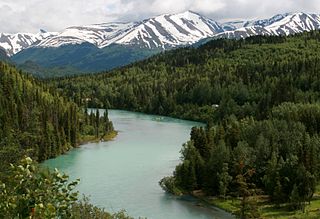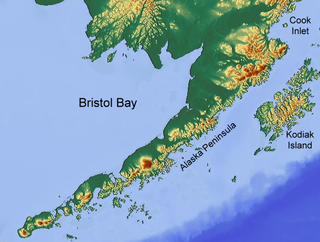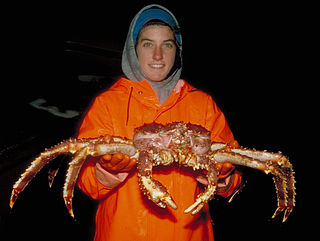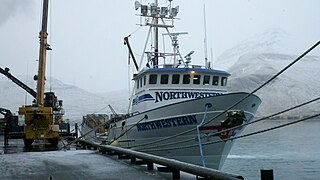Related Research Articles

The Bering Sea is a marginal sea of the Northern Pacific Ocean. It forms, along with the Bering Strait, the divide between the two largest landmasses on Earth: Eurasia and the Americas. It comprises a deep water basin, which then rises through a narrow slope into the shallower water above the continental shelves. The Bering Sea is named after Vitus Bering, a Danish navigator in Russian service, who, in 1728, was the first European to systematically explore it, sailing from the Pacific Ocean northward to the Arctic Ocean.

The Kenai River called Kahtnu in the Dena'ina language, is the longest river in the Kenai Peninsula of southcentral Alaska. It runs 82 miles (132 km) westward from Kenai Lake in the Kenai Mountains, through the Kenai National Wildlife Refuge and Skilak Lake to its outlet into the Cook Inlet of the Pacific Ocean near Kenai and Soldotna.

The Alaska Peninsula is a peninsula extending about 497 mi (800 km) to the southwest from the mainland of Alaska and ending in the Aleutian Islands. The peninsula separates the Pacific Ocean from Bristol Bay, an arm of the Bering Sea.

Bristol Bay is the easternmost arm of the Bering Sea, at 57° to 59° North 157° to 162° West in Southwest Alaska. Bristol Bay is 400 km (250 mi) long and 290 km (180 mi) wide at its mouth. A number of rivers flow into the bay, including the Cinder, Egegik, Igushik, Kvichak, Meshik, Nushagak, Naknek, Togiak, and Ugashik.

The second USS Albatross, often seen as USFC Albatross in scientific literature citations, was an iron-hulled, twin-screw steamship in the United States Navy and reputedly the first research ship ever built especially for marine research.

Deadliest Catch is an American reality television series that premiered on the Discovery Channel on April 12, 2005. The show follows crab fishermen aboard fishing vessels in the Bering Sea during the Alaskan king crab and snow crab fishing seasons. The base of operations for the fishing fleet is the Aleutian Islands port of Dutch Harbor, Alaska. Produced for the Discovery Channel, the show's title is derived from the inherent high risk of injury or death associated with this line of work.

Alaskan king crab fishing is carried out during the fall in the waters off the coast of Alaska and the Aleutian Islands. The commercial catch is shipped worldwide. Large numbers of king crab are also caught in Russian and international waters.

F/V Northwestern is an Alaskan crab, Pacific cod, and salmon tendering commercial fishing vessel featured in the Discovery Channel series Deadliest Catch. To date the Northwestern is the only vessel to have featured on all 19 seasons of Deadliest Catch as well as the pilot series America's Deadliest Season. The vessel is owned and operated by the Hansen family of the state of Washington with Sig Hansen serving as the vessel's primary captain.

The Alaska salmon fishery is a managed fishery that supports the annual harvest of five species of wild Pacific Salmon for commercial fishing, sport fishing, subsistence by Alaska Native communities, and personal use by local residents. The salmon harvest in Alaska is the largest in North America and represents about 80% of the total wild-caught catch, with harvests from Canada and the Pacific Northwest representing the remainder In 2017 over 200 million salmon were caught in Alaskan waters by commercial fishers, representing $750 million in exvessel value. Salmon fishing is a nearly ubiquitous activity across Alaska, however the most valuable salmon fisheries are in the Bristol Bay, Prince William Sound and Southeast regions.

Chionoecetes bairdi is a species of snow crab, alternatively known as bairdi crab and tanner crab. C. bairdi is closely related to Chionoecetes opilio, and it can be difficult to distinguish C. opilio from C. bairdi. Both species are found in the Bering Sea and are sold commercially under the name "snow crab." Tanner crabs have suffered from overfishing and as a result strict controls have been placed on tanner crab fisheries. It was named by Mary Jane Rathbun, a Smithsonian employee who became one of the leading authorities on crab taxonomy. She named the crab for Spencer Baird, her mentor, who in the 1880s as Secretary of the Smithsonian Institution and head of the United States Fish Commission, had given her her first position.

Commercial fishing is a major industry in Alaska, and has been for hundreds of years. Alaska Natives have been harvesting salmon and many other types of fish for millennia Including king crab. Russians came to Alaska to harvest its abundance of sealife, as well as Japanese and other Asian cultures.
This page is a list of fishing topics.

A hand net, also called a scoop net, is a handheld fishing net or meshed basket used to capture and retrieve objects from water, somewhat in the manner of a sieve. It is distinguished from other fishing nets in that the net or mesh is supported by a rigid circular or polygonal frame, which may or may not be mounted to the end of a handle.

Paralithodes platypus, the blue king crab, is a species of king crab from cold waters in the North Pacific Ocean and adjacent seas. Although blue king crabs are among the largest crabs in the world and reputedly may exceed 18 pounds (8.2 kg) in weight, they are generally smaller than red king crabs.

The Bering cisco or Lauretta whitefish is a freshwater whitefish found in Alaska and part of Russia. It is often considered to be the same species as the more common Arctic cisco.

Crab traps are used to bait, lure, and catch crabs for commercial or recreational use. Crabbing or crab fishing is the recreational hobby and commercial occupation of fishing for crabs. Different types of traps are used depending on the type of crab being fished for, geographic location, and personal preference.
The North Pacific Fishery Management Council (NPFMC) is one of eight regional councils established by the Magnuson–Stevens Fishery Conservation and Management Act in 1976 to manage the fisheries of the United States. With jurisdiction over the 900,000-square-mile (2,300,000 km2) Exclusive Economic Zone (EEZ) off Alaska, the Council has primary responsibility for groundfish management in the Gulf of Alaska, Bering Sea and Aleutian Islands, including cod, pollock, flatfish, mackerel, sablefish, and rockfish species. Other large Alaska fisheries such as salmon, crab and herring are managed primarily by the State of Alaska.

NOAAS Oregon, previously NOAAS Oregon, was an American fisheries research vessel in commission in the National Oceanic and Atmospheric Administration (NOAA) fleet from 1970 to 1980. Prior to her NOAA career, she operated under the United States Fish and Wildlife Service from 1949 to 1970 as US FWS Oregon.
Sandy Lake is a lake on the Alaska Peninsula. The lake is located between the Upper Sandy River and Lower Sandy River, which drains into the Bering Sea. It lies 25 miles north-east of Port Moller Airport and is on the boundary of the Alaska Peninsula National Wildlife Refuge. Mount Veniaminof lies to the west of the lake.
The Pacific Salmon War was a period of heightened tensions between Canada and the United States over the Pacific Salmon catch. It began in 1992 after the first Pacific Salmon Treaty, which had been ratified in 1985, expired, and lasted until a new agreement was signed in 1999. Disagreements were high in 1994, when a transit fee was set on American fishing vessels using the Inside Passage and a ferry was blockaded by fishing boats in Friday Harbor, Washington.
References
- ↑ "Corey Arnold". National Geographic. May 18, 2018. Retrieved March 22, 2019.
- 1 2 3 4 5 6 "Filson Life – Fish-Work: An Interview with Commercial Fisherman and Photographer Corey Arnold". Filson. Retrieved March 22, 2019.
- 1 2 3 "Feature: An Interview with Corey Arnold". Juxtapoz Magazine. Retrieved March 22, 2019.
- ↑ Traff, Thea (August 21, 2014). "Gone Fishing". The New Yorker. ISSN 0028-792X . Retrieved March 22, 2019.
- 1 2 Newman, Jesse (January 21, 2013). "Eat, Sleep, Fish, Click". Lens Blog. Retrieved March 22, 2019.
- ↑ "Wonder and Violence on the Bering Sea". Feature Shoot. May 8, 2017. Retrieved March 22, 2019.
- ↑ "Jaime Lowe Interviews Corey Arnold". Daylight Books. Retrieved March 22, 2019.
- ↑ "Corey Arnold biography – Richard Heller Gallery". richardhellergallery.com. Retrieved March 22, 2019.
- ↑ "Episode 10: Corey Arnold: Photographer/Commercial Fisherman, PT. 1". Backdrop. Retrieved March 22, 2019.
- ↑ Photographer, Corey Arnold-. "Press & Awards | Corey Arnold – Photographer". coreyfishes.com. Retrieved August 17, 2019.
- ↑ "First Place | Feature Picture Story". poy.org. Retrieved March 22, 2019.
- ↑ "Corey Arnold". Nazraeli Press. Retrieved March 22, 2019.
- ↑ "The fishing squatter community living in an abandoned Alaskan salmon cannery". Freunde von Freunden. Retrieved March 19, 2019.
- ↑ Arnold, Corey (March 29, 2018). "The Secret Lives of Commercial Fishermen". Outside Online. Retrieved March 22, 2019.
- ↑ "Juxtapoz Wild: Corey Arnold". Juxtapoz Magazine. Retrieved March 22, 2019.
- ↑ "How To Be An Alaskan Fisherman". FECAL FACE DOT COM. Retrieved March 22, 2019.